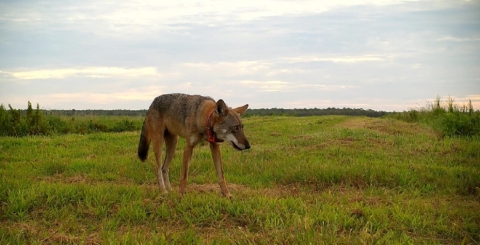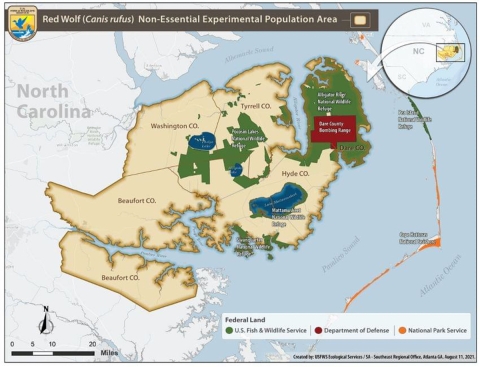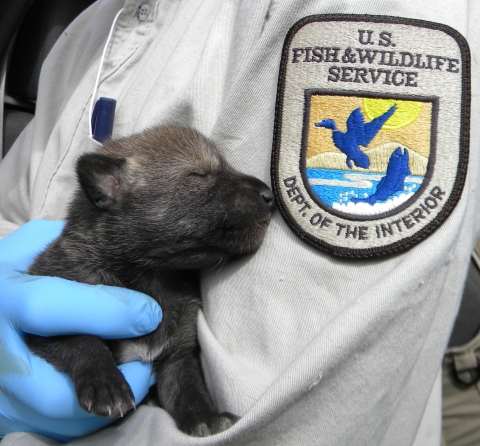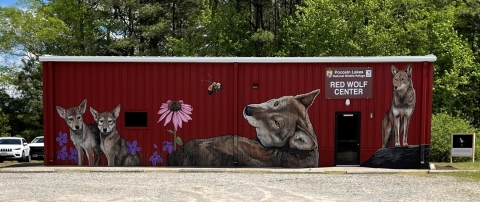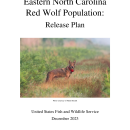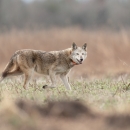States
North CarolinaRed Wolf Recovery Program
2024-2025 Release Plan available NOW...click HERE!
Canis rufus
- Taxon: Mammal
- Range: Eastern North Carolina
- Status: First listed as “threatened with extinction” under the Endangered Species Preservation Act of 1966 in 1967. Currently listed as an "endangered species" under the Endangered Species Act of 1973.
- Population estimate as of February 2025:
- Known/collared (wild): 16
- Total estimate (wild): 17-19
- Red Wolf SAFE (captive): 270
Red Wolf Recovery Program Updates - September 2024
Wild Population Update/2024 Releases
On December 1, 2023 the Service published the 2023-2024 release plan. The plan discloses efforts undertaken from October 2023 through June 2024 in support of Red Wolf recovery in eastern North Carolina specific to the pairing and release strategies during that time frame. The following summary includes updates on those efforts and updates on the wild population as of September 2024.
September 2024
Based on extensive monitoring, using multiple monitoring methods, there is no indication that the litter born to 2413F and 2444M survived after the mortality of 2444M on Highway 64 in early June. Pup survival is always a concern after the mortality of one of the breeding pair, particularly red wolves with their first litter, such as was the case with this pair. No carcasses have been found to confirm this.
In mid-June, 2499M was detected as a mortality during tracking and monitoring. Radio collars have a mechanism that changes the signal transmitted when the collar has not moved for a specified period of time, which we hear when they are being actively tracked. The cause of death is unknown at this time, and his mortality is currently under investigation.
The Milltail litter, born to 2225F and 2191M in April, has not been definitively detected and identified during monitoring with remote sensing cameras, tracking and visual observation since late June. Their known activity areas were buffered from management activities during that time. Monitoring will continue throughout their home range. No pup mortalities have been documented, however, pups approaching 5 months old are typically moving throughout the family group’s home range with the adults and being seen on remote sensing cameras.
June 2024
In February 2024, a wild female Red Wolf (2359F), fostered into a den in 2021, was captured by private trappers and handed over to Red Wolf Recovery Program biologists. To try and create a new breeding pair, she was placed in an acclimation pen on PLNWR with a male (2443M) born in 2022 at the Endangered Wolf Center as part of the Red Wolf SAFE Program. They did not have a litter in the pen. Based on results from previous releases under similar circumstances (e.g., no litter, a male Red Wolf from the SAFE Program with no wild experience and the fact that they were not in the pen together during the bonding period or the full mating period due to the timing of her capture), 2359F was released in June 2024, but 2443M was not and will remain in the pen for now. Attempts will be made in the future to pair him with a wild female Red Wolf and release him if it is a successful pairing.
2024 Releases
In February 2024, a wild female Red Wolf (2359F), fostered into a den in 2021, was captured by private trappers and handed over to Red Wolf Recovery Program biologists.To try and create a new breeding pair, she was placed in an acclimation pen on PLNWR with a male (2443M) born in 2022 at the Endangered Wolf Center as part of the Red Wolf SAFE Program.They did not have a litter in the pen. Based on results from previous releases under similar circumstances (e.g., no litter, a male Red Wolf from the SAFE Program with no wild experience and the fact that they were not in the pen together during the bonding period or the full mating period due to the timing of her capture), 2359F was released in June 2024, but 2443M was not and will remain in the pen for now.Attempts will be made in the future to pair him with a wild female Red Wolf and release him if it is a successful pairing.
In December 2023, a wild female Red Wolf (2413F) born into the Milltail family group in 2022 was captured by Red Wolf Recovery Program biologists and placed in an acclimation pen on ARNWR with a male (2444M), born in 2022 at the Endangered Wolf Center as part of the Red Wolf SAFE Program, to try and create a new breeding pair. In April 2024, the newly formed pair had a litter of 5 pups in the acclimation pen and they were all released in late May. Based on extensive monitoring using various methods (e.g., visual observations from a far distance, remote cameras, radio telemetry tracking from the ground and air, points from GPS collars via satellites), the family group moved a few miles away from the acclimation pen and settled in, including 2444M appearing to be transitioning well into the wild and as a new father. Tragically, his transition to the wild was cut way too short and he was a vehicle strike mortality on Highway 64 near Buffalo City Road on June 5. Monitoring of 2413F and the pups will continue, and feasible management actions will be taken to assist with survival of the pups, if possible, after the loss of the male.
In November 2023, a wild female Red Wolf (2409F), who had previously been released as part of a family group on Pocosin Lakes National Wildlife Refuge (PLNWR) in May 2023, and a wild male Red Wolf (2411M) born into the Milltail family group in 2022, were captured separately by Red Wolf Recovery Program biologists and placed in an acclimation pen together on ARNWR to try and create a new breeding pair. They did not have a litter and were subsequently released in June 2024. Both are fitted with orange GPS/VHF collars and will be monitored.
Wild Population Update
On April 18, 2024, Red Wolf Recovery Program biologists confirmed the birth of a wild litter of 8 Red Wolf pups in the Milltail area of Alligator River National Wildlife Refuge (ARNWR). While this is the third year in a row for a litter in that area, it was far from a given that it would occur this year after the tragic loss of 2323M (the previous breeding male in the Milltail family group) in September 2023. In an attempt to create a new breeding pair, an acclimation pen was constructed in October 2023 within the home range of the resident wild adult female Red Wolf (2225F), who birthed the previous two litters. A male Red Wolf (2191M), born at Wolf Haven International in Tenino, Washington as part of the Red Wolf Saving Animals From Extinction (SAFE) program, was then placed in it (See October 2023 summary for 2225F and 2191M below). His release from the pen in late January 2024 was timed with mating season and he and 2225F soon appeared to become a pair. Close monitoring throughout the winter and early spring raised hopes that this new pairing would be successful, and it was. When the pups were about 9 days old, biologists went into the den to quickly examine the pups, microchip them for future identification and cheek swabbed for genetics before leaving the den, allowing 2225F to quickly return to continue caring for the pups. The family group will continue to be monitored without disturbing them.
On April 15, 2024, a 2-year-old wild male Red Wolf (2410), born in the Milltail pack in 2022, was a mortality on Highway 64 in the East Lake area. Necropsy confirmed that it was as a result of a vehicle strike. Necropsy results are pending. Prior to his mortality, monitoring indicated that he had been crossing the highway in that area and efforts were ongoing to haze him away from the highway and to capture/relocate him.
On April 8, 2024, a wild female Red Wolf (2280) was captured after exhibiting uncharacteristic behavior for her, such as being visible close to open farm field roads, acting very lethargic, and appearing to have vision issues. After an initial evaluation at a local vet clinic, she was moved to the North Carolina State University (NCSU) Veterinary Hospital where she was diagnosed with an untreatable cancerous mass on her brain. The decision was then made to humanely euthanize her. Her medical care at the NCSU Veterinary Hospital was paid for by the Red Wolf Coalition.
On February 25, 2024, an adult wild female Red Wolf (2538) was captured on private lands and added to the known population. She is estimated to be 7 years old.
On January 26, 2024, 2191M and 2414F were released from the acclimation pen. Their movements and activity will be monitored closely over the coming weeks and months.
In January 2024, four of the Red Wolf pups (2499M, 2500M, 2502F and 2503F) born into the Milltail family group on Alligator River National Wildlife Refuge in Spring 2023 were captured, fitted with orange collars with orange reflective material, and re-released. We did not capture the male pup fostered into the family group and have not been able to identify him on remote sensing camera footage for the last couple of months.
| Red Wolf ID | Letter/Number on Collar |
| 2191M | T |
| 2500M | V |
| 2502F | 9 |
| 2503F | 6 |
On November 19, 2023, a female pup (2501F) born in the Milltail family group in spring 2023 was captured. She was radio collared with an orange radio collar with orange reflective material and re-released. Unfortunately, on December 22, 2023 she was killed on Highway 264. Necropsy confirmed the mortality was a result of a vehicle strike.
On November 19, 2023 and the following day on November 20, 2023, the two remaining pups (2514F and 2515F) born in the Pungo family group in spring 2023 were captured. They were both collared with orange collars with orange reflective material and released within their family group’s home range where they have remained with the breeding pair (2361F and 2307M).
| Red Wolf ID | Letter/Number on Collar |
| 2514F | A |
| 2515F | 7 |
In October 2023 an acclimation pen was constructed on Alligator River National Wildlife Refuge within the territory of the Milltail family group breeding female (2225F) with the intention of trying to introduce a male Red Wolf. On October 30, 2023, a male from the SAFE population (2191M) was placed in the acclimation pen. The pen was constructed in a way to allow for the wild Red Wolves to be able to interact with and get familiar with the male in the pen with the hope that after release he would pair with 2225F. Soon after his placement in the pen, the Milltail pups began directly interacting with him through the fence and 2225F would come to the area periodically. In December 2023, one of the female yearlings (2414F) from the Milltail family group was captured and placed in the acclimation pen with 2191M. She was placed in the pen not with the intention that the two would pair but to increase the likelihood of him being accepted into the family group after release, both because the Red Wolves in the pen would be more familiar with one another and because it would likely increase the amount of interactions between the family group and the two in the acclimation pen. 2225F visited the pen more after her daughter was inside.
General Updates - 2023
On 7/5/23 during routine radio telemetry monitoring in the Pungo area of Pocosin Lakes NWR, a 7-year-old wild female Red Wolf (2197F) was in mortality mode and subsequently found on the shoulder of a road. Necropsy results are pending. She was the wild female Red Wolf female that pups were fostered with in 2021.
On 7/11/23 a Red Wolf pup (2522F) was reported injured on Pocosin Lakes National Wildlife Refuge (NWR). That pup died as a result of her injuries, despite efforts to save her, including extensive efforts at the NCSU Veterinary Hospital. Later that same day a mortality notification was received for her father, the breeding male (2132M) of the family group from the SAFE population released on central Pocosin Lakes NWR in late May. Necropsy results are pending on both mortalities and are part of an ongoing law enforcement investigation. Shortly after these mortalities, the breeding female (2287F) released from the SAFE population as part of this family group dispersed from the refuge for the first time and later became involved with the depredation of chickens on multiple occasions. She was captured on 9/29/23 by the Red Wolf field team and placed back into the SAFE population. Monitoring to date appears to indicate that the remaining pups from this family group were likely abandoned after the mortalities and 2287F’s move off the refuge.
On 7/20/23 we received a mortality notification for the wild female Red Wolf (2322F) that was translocated from St. Vincent NWR and released in early May 2023 on Alligator River NWR. Necropsy results are pending as part of an ongoing law enforcement investigation.
On 8/7/23, Service law enforcement issued a press release requesting information and offering a $5,000 reward regarding the mortality of a newly released male (2326M) from the SAFE population that occurred on private land on 5/18/23, which has been confirmed to be from gunshot.
On 9/26/23, an orange collared Red Wolf was reported dead along Highway 64 on the section running through Alligator River NWR. Once on the scene, the Red Wolf team identified the mortality as the wild male Red Wolf (2323M) who was the breeding male of the of the Milltail family group. Necropsy results indicate that the cause of death was a vehicle strike.
Family Groups
The Milltail breeding female (2225F), 5 yearlings (2410M, 2411M, 2412F, 2413F and 2414F) and 6 pups (as of September 2023) remain within their expected area of use on Alligator River NWR.
The breeding pair (2361F and 2307M) and 2 pups (as of September 2023) remain within their expected area of use on and around Pocosin Lakes NWR.
Recovery Planning
On September 29, 2023, the Service released the final Revised Recovery Plan for the Red Wolf (Canis rufus). This revised recovery plan was developed by the Red Wolf Recovery Team, a collaborative partnership consisting of Tribal Nation representatives, State and Federal agencies, County government, academia, zoos/conservation centers, non-profit organizations, non-governmental organizations, and landowners, assembled in July 2021. The Red Wolf Recovery Plan was last revised in 1990.
The Recovery Team followed the Service’s Recovery Planning and Implementation Process, a three-document approach consisting of:
- A Species Status Assessment (SSA) – Completed in 2018, this document evaluates red wolf viability and provides the foundational biological information to develop and support a recovery plan.
- A Recovery Plan – A concise, visionary document that contains the elements required under section 4(f)(1)(B) of the ESA: recovery criteria, recovery actions, and time and cost estimates.
- A Recovery Implementation Strategy – An itemization of the prioritized on-the-ground activities needed to implement the actions identified in the recovery plan. Development of the Recovery Implementation Strategy is under way by the Red Wolf Recovery Team and is expected to be completed in 2024.
At the same time the revised recovery plan was released, the Service also released the Population Viability Analysis of the Red Wolf (PVA), which was used to inform the final recovery plan. Frequently asked questions can also be found on our website.
The plan underscores the Service’s commitment to working with others to conserve the Red Wolf. Collaborative conservation is foundational to the successful recovery of the species and the Service will continue to strive to align our work with the needs of communities and contributors involved in Red Wolf recovery.
Red Wolf ID | Letter/Number on Collar |
2322F | F |
2344M | G |
2359F | 4 |
2326M | E |
2361F | D |
2307M | H |
2287F | I |
2132M | J |
2409F | K |
On December 1, 2023 the Service published the 2023-2024 release plan. The plan discloses efforts being undertaken from October 2023 through June 2024 in support of Red Wolf recovery in eastern North Carolina specific to the pairing and release strategies during that time frame.
Research
Studies are underway to identify the possibility of Red Wolf ancestry still remaining in the wild in southwestern Louisiana and southeastern Texas. These studies follow-up on previous studies (Murphy et al. 2018 and Heppenheimer et al. 2018) that suggest Red Wolf ancestry may still exist on the landscape in Louisiana and Texas.
Program History
The recovery of the Red Wolf began as a remarkable conservation success story. By 1972, the species was reduced to a small coastal area in southeast Texas and southwest Louisiana (see map above). From 1973-1980, the Service began trapping wild canids in the area to prevent extinction of the species and establish a captive breeding program with the intention of reintroducing the species in the wild. In the early 1970’s, Point Defiance Zoo and Aquarium, in association with the Service, established a captive-breeding program using 14 Red Wolves. After numbers continued to decline due to human persecution and habitat loss, the Red Wolf was subsequently declared extinct in the wild in 1980.
In 1984, the captive breeding program was approved by the Association of Zoos and Aquariums (AZA) as the Red Wolf Species Survival Plan (SSP) program, which provides oversight for maintaining a healthy and genetically diverse stock under human care. By this time, there were approximately 63 individuals in the SSP population and the program was actively growing the population through the coordinated efforts of the SSP partner facilities, making reintroduction efforts possible.
Recovery efforts in the wild began in northeastern North Carolina with the establishment of what is referred to today as the Eastern North Carolina Red Wolf Population (ENC RWP) under section 10(j) of the ESA and release of Red Wolves from the SSP population, on Alligator River NWR in 1987. Between 1987 and 1994, over 60 adult red wolves from the SSP population were released into the ENC RWP. By the mid-1990s, Red Wolves in the wild maintained territories, formed packs, and successfully bred. By 2011, this reintroduction effort culminated in a known population (e.g. radio-collared) of 89 Red Wolves and in 2012 an estimated population as high as 120 Red Wolves within the five-county ENC RWP area. This was the first time a large carnivore had been declared extinct in the wild and then reintroduced in the United States. It set the stage for several subsequent reintroduction efforts that were modeled after the Red Wolf Recovery Program, such as gray wolves in Yellowstone and central Idaho, Mexican wolves in the southwestern U.S., California condors, and black-footed ferrets. Several innovative recovery tactics were first attempted by this program, with a great deal of success, including pup fostering and coyote sterilizations.
In 1990, the Service established an island propagation site for the Red Wolf at St. Vincent NWR, an isolated island off the Gulf Coast of Florida. The role of this site is to propagate Red Wolf pups in a somewhat controlled, but natural environment that will provide them with a wild experience as juveniles for the purpose of being strategically translocated into the wild.
Red Wolf SAFE Population
In 2018, the Red Wolf was named one of the Association of Zoo and Aquariums’ (AZA) SAFE (Saving Animals From Extinction) species. The SAFE program focuses the collective expertise within AZA-accredited zoos and aquariums and leverages their massive audiences to save species. The Red Wolf SAFE program’s goal is to support conservation efforts for this species by maintaining a healthy and viable population of Red Wolves under human care, growing education and awareness efforts, and aiding research vital to supporting recovery and management. Before the SAFE program, the Red Wolf population under human care (i.e., captive population) was overseen by AZA’s Species Survival Plan (SSP) program. Management of this population under the SAFE program is the same as it was under the SSP program.
Captive breeding saved the Red Wolf from extinction and is an essential component of Red Wolf recovery. Past releases of Red Wolves from the population under human care into the ENC RWP helped the wild Red Wolf population reach a peak of 120 animals in 2012. Although captive Red Wolves are located throughout the country at different Red Wolf SAFE facilities, they are managed as a single population. They are routinely transferred among the facilities to breed according to genetic management objectives to help maintain the health and diversity of an increasing population.
Human contact with captive Red Wolves is minimized to promote avoidance behavior and to support pair bonding, breeding, pup rearing, and healthy pack structure structure
Something temporarily or permanently constructed, built, or placed; and constructed of natural or manufactured parts including, but not limited to, a building, shed, cabin, porch, bridge, walkway, stair steps, sign, landing, platform, dock, rack, fence, telecommunication device, antennae, fish cleaning table, satellite dish/mount, or well head.
Learn more about structure . They are evaluated and selected for release to the wild based on their genetic makeup, reproductive performance, behavior, and physical suitability.
In 2016, the Service made increasing the size of the Red Wolf population under human care (the captive population - see Red Wolf SAFE section) a priority. The Service stated it would provide resources and work with its partners to expand space capacity. To date, the Service has provided $771,000 through FY18, FY19, and FY20 Recovery Challenge Grants for the construction of additional Red Wolf enclosures. And to date, 30 new enclosures have been built or funded.
As of October 2023, there are approximately 267 Red Wolves in 50 Red Wolf SAFE facilities across the country. In the 2021-2022 breeding season, 28 breeding pairs were established and 46 pups in 13 litters were born - of which 29 survived, adding to the SAFE population. With additional space capacity, and to increase the population, the number of breeding pairs for the 2022-2023 breeding season increased to 40 pairs. This resulted in 18 litters and 78 puppies – of which 56 survived and added to the SAFE population. For the 2023-2024 breeding season, 33 breeding pairs have been suggested.
Wild Population
Under Section 10(j) of the ESA, the Service can designate reintroduced populations established outside of the species’ current range, but within its historical range, as “experimental.” This designation allows the Service to reestablish self-sustaining populations when doing so fosters its conservation and recovery.
Currently, there is only one wild population of Red Wolves, the ENC RWP in eastern North Carolina, which encompasses five counties of the Albemarle Peninsula in eastern North Carolina (Beaufort, Dare, Hyde, Tyrrell, and Washington counties). Management of the ENC RWP Red Wolves is conducted in accordance with the 10(j) rule published in 1995, as clarified by relevant court orders. Notably, this includes a permanent injunction prohibiting take of Red Wolves either directly or by landowner authorization, without first demonstrating that the Red Wolf is a threat to human safety or the safety of livestock or pets. Additionally, the 1995 rule recognizes the Service’s authority to release additional Red Wolves and conduct adaptive management within the ENC RWP.
Past reintroductions into the ENC RWP helped support a wild Red Wolf population as high as 120 animals (89 radio collared) in 2012. After peaking, the population declined dramatically. Human-caused mortality (e.g., gunshots, vehicle strikes) has been the leading cause of this decline. Hybridization with coyotes, which is exacerbated by human-caused mortality, particularly in breeding pairs, and low Red Wolf population numbers also played a key role in this decline.
Due to declining population size and the mortality of one or both Red Wolves in established breeding pairs, there were no known Red Wolf pups born in the wild in 2019, 2020 or 2021, which is the first time that has occurred in over 30 years. But on April 19, 2022, a wild Red Wolf litter of 6 pups (4F, 2M) was confirmed on Alligator River NWR from Red Wolf pair 2225F and 2323M – the first wild red wolf litter born since 2018!
| Red Wolf ID | Letter on Collar |
| 2410M | S |
| 2411M | R |
| 2412F | M |
| 2413F | O |
| 2414F | N |
The total population is an estimate based on known radio-collared Red Wolves, adult Red Wolves with radio collars that quit functioning relatively recently that are likely still on the landscape, pups of the years that are too small to be collared, and an additional few un-collared adult Red Wolves that could potentially be on the landscape based on reported sightings and remote sensing cameras.
The Service is committed to seeing Red Wolf numbers increased within the ENC RWP. The Service will continue to collar all captured Red Wolves with bright orange collars to help the public distinguish them from coyotes. Currently, all known, collared adult Red Wolves have orange collars. The Service is also continuing releases of Red Wolves from the SAFE population into the ENC RWP and conducting adaptive management. See below for management activities implemented to attempt to create Red Wolf breeding pairs in eastern North Carolina.
Management
2020-2021 Management Activities
2021-2022 Management Activities
2022-2023 Management Activities
Eastern North Carolina Red Wolf Population (ENC RWP)
On October 4, 2022 and May 9, 2023 the Service hosted in-person public meetings in Columbia, NC and Swan Quarter, NC, respectively, and on October 5, 2022 and May 10, 2023 the Service hosted virtual public meetings to talk about the status of Red Wolf recovery, the planned releases of captive adult Red Wolves, coyote sterilization, Prey for the Pack, and increased community engagement.
In late fall/early winter 2022, six Red Wolves (3 individual males and a family group of 3 – breeding pair and a pup) from the Red Wolf SAFE population were transferred to the Service for eventual release within the ENC RWP in Spring 2023. Additionally, a wild female Red Wolf was captured and translocated to eastern North Carolina from St. Vincent NWR in Fall 2022.
One male from the SAFE population was placed in an acclimation pen on Alligator River NWR with the wild female Red Wolf translocated from St. Vincent NWR. The other two of the males from the SAFE population were place in separate acclimation pens with wild female Red Wolves captured within their territories on Pocosin Lakes NWR. These two wild female Red Wolves were fostered into a den in 2021. The family group from the SAFE population was placed in an acclimation pen on Pocosin Lakes NWR. Acclimation pens were placed in areas where there were no existing Red Wolf pairs and the area provided adequate prey densities and security. All Red Wolves to be released were collared with orange GPS/VHF collars with orange reflective material prior to placement in the acclimation pens.
The plan was to leave them in the acclimation pens through the breeding and whelping season because the best available information and experience indicates that when trying to form new Red Wolf pairs, they are more likely to stay together and stay in the area of release when they have pups, even if the pups don’t survive.
Each of the adults/juveniles were fitted with orange GPS/VHF collars for tracking purposes and to identify them as a Red Wolf and illegal to shoot, as well as orange reflective material to increase their visibility along roadways. Each collar has a black letter or number on it to help identify them on remote sensing cameras and during sightings.
Red Wolf ID | Letter/Number on Collar |
2322F | F |
2344M | G |
2359F | 4 |
2326M | E |
2361F | D |
2307M | H |
2287F | I |
2132M | J |
2409F | K |
In January 2023, wild adult male 2101M was a mortality within his normal home range on private land. He was almost 9 years old and in poor health with mange and a heart condition. Not long before his death, we observed him with a substantial leg injury.
In January/February 2023 the 5 Milltail pups from the 2022 litter, 3 females (2412F, 2413F and 2414F) and 2 males (2410M and 2411M), were captured and fitted with radio collars. When captured they ranged in weight from about 40 pounds to almost 55 pounds and will continue to grow. They have orange radio collars to identify them as Red wolves to help with their protection and to allow for monitoring, particularly as some or all of them will naturally disperse over the next year or so. Each of their radio collars also has reflective material to increase their visibility along roadways and a letter to help identify them on remote sensing cameras and from sightings.
| Red Wolf ID | Letter on Collar |
| 2410M | S |
| 2411M | R |
| 2412F | M |
| 2413F | O |
| 2414F | N |
In March 2023, wild adult female 1849F, one of the well-known and key wild Red Wolves on Alligator River NWR for more than a decade, passed away of natural causes. Born in 2010 on the Refuge, 1849F spent her life there and was the matriarch of the Milltail family group for many years, including having 3 litters and 14 pups over her 13 years of life in the wild.
In April 2023, 2029F, a 10-year old wild female Red Wolf, was discovered dead on private land during routine radio telemetry tracking. A cause of death cannot be determined.
In April 2023, the breeding female of the Milltail family group (2225F) on Alligator River NWR had a litter for the second year in a row. The litter was 5 pups (3 females, 2 males) born on approximately April 11, 2023. On April 20, 2023, USFWS located and entered the den to do a general health check of the pups, take genetic samples and microchip them for future identification. Through coordination with the Red Wolf SAFE program, it was determined that there was one litter born in a SAFE facility close enough in time to the wild litter to conduct pup fostering. Because the wild female already had 5 pups in the wild litter, it was decided to only foster in one pup so as not to overburden her. On April 23, 2023, a male pup from the SAFE population was flown to the ENC RWP and transferred to USFWS. On the morning of April 24, 2023, the foster pup was placed into the wild den creating a litter of 6 pups (3 females, 3 males).
In April 2023, one of the newly formed pairs consisting of a wild female within her territory and a male from the SAFE population, and the family group from the SAFE population, each had 4 pups while in the acclimation pens, though one of the pups was a mortality prior to release. The other newly formed pairs in acclimation pens did not have pups and were released in early May. The pairs with pups were released in late May when the pups were around 6 weeks old and mobile enough to ensure they would be able to follow their parents out of the acclimation pen. Releases from the pen consist of placing remote sensing cameras around the pen the day prior to document their release and then on the day of release simply opening the door and leaving. They are then free to come and go from the pen as they choose.
Every newly released Red Wolf was tracked, monitored and their status assessed on a daily basis following release. Newly released Red Wolves were also supplementally fed with natural prey items when and where feasible to help with their transition to the wild. Additionally, Service staff contacted private landowners where Red Wolves were known to be spending time, based on tracking/monitoring. This was done to make landowners aware of the presence of Red Wolves and to address any potential concerns or issues.
On May 18, 2023, the Red Wolf field team received, and subsequently verified, a mortality notification for 2326M, a male from the SAFE population who was released from an acclimation pen on Pocosin Lakes NWR earlier that month. On 8/7/23, USFWS law enforcement issued a press release offering a $5,000 reward for information regarding this mortality on private land that was confirmed to be from gunshot.
In May 2023, the male (2344M) from the SAFE population released from an acclimation pen on Alligator River NWR in May 2023, was captured by the Red Wolf field team due to substantial concerns regarding his ability to survive in the wild as a result of his unwillingness to leave a rural neighborhood and his complacency around people and pets, despite repeated hazing/harassment over several days. He was subsequently transferred back into the SAFE population.
In June 2023, the 14-year-old wild female Red Wolf (1743F) on Alligator River NWR was found to be in mortality mode during routine tracking. She was subsequently found to have died within a wood block in the Milltail area. Necropsy results confirmed she died of natural causes. She was born in the Milltail area in 2009 and spent the majority of her life on the bombing range which is surrounded by Alligator River NWR, but in recent years split her time between the bombing range and the Milltail area. She is the oldest known ever wild Red Wolf on record.
In July 2023, during routine radio telemetry monitoring in the Pungo area of Pocosin Lakes NWR, a 7-year-old wild female Red Wolf (2197F) was in mortality mode and subsequently found on the shoulder of a road. Necropsy results are pending. She was the wild female Red Wolf that pups were fostered with in 2021.
In July 2023, a Red Wolf pup (2522F) was reported injured on Pocosin Lakes NWR. That pup later died as a result of her injuries, despite efforts to save her, including extensive efforts at the NCSU Veterinary Hospital. Later that same day a mortality notification was received for her father, the breeding male (2132M) of the family group from the SAFE population released on central Pocosin Lakes NWR in late May. Necropsy results are pending on both mortalities and are part of an ongoing law enforcement investigation. Shortly after these mortalities, the captive- born breeding female (2287F) of this family group dispersed from the refuge for the first time and later became involved with the depredation of chickens on multiple occasions. She was captured on 9/29/23 by the Red Wolf field team and placed back into the SAFE population. Monitoring to date appears to indicate that the remaining pups from this family group were likely abandoned after the mortalities and 2287F’s move off the refuge.
In July 2023, the Red Wolf field team received a mortality notification for the wild female Red Wolf (2322F) that was translocated from St. Vincent NWR and released in early May 2023 on Alligator River NWR. Necropsy results are pending as part of an ongoing law enforcement investigation.
In September 2023, an orange collared Red Wolf was reported dead along Highway 64 on the section running through Alligator River NWR. Once on the scene, the Red Wolf team identified the mortality as the wild male Red Wolf (2323M) who was the male of the of the Milltail family group. Necropsy results indicate that the cause of death was a vehicle strike.
As of September 2023, the Pungo family group on Pocosin Lakes NWR consisted of the breeding pair (2361F and 2307M) and two pups.
As of September 2023, the Milltail family group on Alligator River NWR consisted of the breeding female (2225F), 5 yearlings (2410M, 2411M, 2412F, 2413F and 2414F) and 6 pups.
Service staff have continued to develop additional Prey for the Pack agreements throughout the ENC RWP and have completed some in key locations adjacent to Alligator River NWR. Prey for the Pack agreements are tailored to each landowner and include technical and financial assistance to them to implement habitat improvement projects that benefit the landowner and wildlife. Each agreement includes a commitment by the landowner to allow Red wolves to use their property without harassment. Depending on the comfort of the landowner, additional activities, such as trapping and coyote sterilization, may also be included. The Service and its partners are also continuing to look for ways to expand this program or develop sister programs suited to the needs of local landowners.
St. Vincent National Wildlife Refuge, Florida (SVNWR)
There is currently a pair of Red Wolves on St. Vincent NWR, but a successful litter was not documented in 2023 based on monitoring.
Summary of Releases
| Year | # of Adults Released | # of Subadults Released | # of Pups Released w/Adults1 | # of Pups Fostered | # of Known Pups Born in the Wild | # of Known Mortalities | Population Estimate2 (end of year) | # of Mortalities as a Function of Population |
|---|---|---|---|---|---|---|---|---|
| 1987 | 8-C | 0 | 0 | 0 | 0 | 1 | 7 | 14% |
| 1988 | 0 | 2-C | 0 | 0 | 2 | 4 | 16 | 25% |
| 1989 | 1-C | 6-C | 2-C, 2-I | 0 | 0 | 3 | 15 | 20% |
| 1990 | 2-C | 0 | 6-C | 0 | 0 | 6 | 31 | 19% |
| 1991 | 1-C | 1-C | 5-C | 0 | 13 | 9 | 34 | 26% |
| 1992 | 2-I | 0 | 4-C | 0 | 2 | 1 | 43 | 2% |
| 1993 | 2-C, 2-I | 2-C | 9-C | 0 | 16 | 8 | 66 | 12% |
| 1994 | 3-C, 3-I | 0 | 0 | 0 | 34 | 23 | 51 | 45% |
| 1995 | 1-C | 1-S | 0 | 0 | 22 | 12 | 41 | 29% |
| 1996 | 2-I | 3-I | 0 | 0 | 19 | 7 | 50 | 14% |
| 1997 | 1-I | 1-I | 0 | 0 | 19 | 9 | 44 | 20% |
| 1998 | 0 | 1-I | 0 | 0 | 13 | 15 | 66 | 23% |
| 1999 | 1-I | 2-I | 0 | 0 | 44 | 16 | 89 | 18% |
| 2000 | 1-S,1-I | 1-S,2-I | 0 | 0 | 26 | 16 | 96 | 17% |
| 2001 | 1-S | 0 | 0 | 0 | 35 | 22 | 86 | 26% |
| 2002 | 0 | 1-I | 0 | 7-C | 32 | 22 | 81 | 27% |
| 2003 | 0 | 1-I | 0 | 0 | 35 | 15 | 87 | 17% |
| 2004 | 0 | 0 | 0 | 2-I | 50 | 21 | 94 | 22% |
| 2005 | 0 | 1-I | 0 | 0 | 38 | 19 | 103 | 18% |
| 2006 | 0 | 4-I | 0 | 4-C | 52 | 18 | 110 | 16% |
| 2007 | 0 | 0 | 0 | 3-C | 31 | 21 | 94 | 22% |
| 2008 | 0 | 3-I | 0 | 0 | 47 | 21 | 97 | 22% |
| 2009 | 0 | 5-I | 0 | 4-C | 40 | 28 | 94 | 30% |
| 2010 | 0 | 0 | 0 | 2-C | 43 | 17 | 95 | 18% |
| 2011 | 0 | 0 | 0 | 2-C | 40 | 21 | 90-110 | 19-23% |
| 2012 | 0 | 0 | 0 | 2-C | 39 | 20 | 100-120 | 17-20% |
| 2013 | 0 | 0 | 0 | 1-C | 34 | 15 | 90-110 | 14-17% |
| 2014 | 0 | 0 | 0 | 2-C | 19 | 17 | 90-110 | 15-19% |
| 2015 | 0 | 0 | 0 | 0 | 10 | 19 | 50-75 | 25-38% |
| 2016 | 0 | 0 | 0 | 0 | 11 | 11 | 25-48 | 23-44% |
| 2017 | 0 | 0 | 0 | 0 | 4 | 7 | 25-35 | 20-28% |
| 2018 | 0 | 0 | 0 | 0 | 4 | 5 | 23-30 | 17-22% |
| 2019 | 0 | 0 | 0 | 0 | 0 | 6 | 19-22 | 27-32% |
| 2020 | 0 | 1-I | 0 | 0 | 0 | 2 | 17-20 | 10-12% |
| 2021 | 2-C,1-I | 2-C,1-I | 0 | 4-C | 0 | 7 | 17-20 | 35-41% |
| 2022 | 7-C | 3-C | 0 | 0 | 6 | 6 | 19-21 | 29-32% |
| 2023 | 5-C, 1-I | 1-C | 0 | 1-C | 13 | 11 | 20-23 | 50-55% |
C = Captivity
I = Island Propagation Site
S = Great Smoky Mountains National Park
Adults are categorized as Red Wolves 3 years of age or older. Subadults are Red Wolves that are greater than 6 months old and less than 3 years old. Pups are Red Wolves less than 6 months old.
1Origin of Red Wolves Released or Fostered
2The methodology used to determine the population estimate of the ENC RWP has varied over the course of time based on the size of the population to yield the most accurate estimates possible.
3Information as of 6/26/2023
** Specific information about mortality location is not released as it may provide sensitive species occurrence data. **
Outreach, Education, and Media
Interested in learning how to help Red Wolves? Check out our fact sheet here.
Traveling in eastern North Carolina? Here's how you can help keep Red Wolves safe. Check out our "Welcome to Red Wolf Country" brochure.
Service staff have worked closely with multiple local, regional and national media outlets on articles, news stories, and videos to get the word out about the release of Red Wolves and Red Wolf recovery in general. Outlets include, but are not limited to, Mutual of Omahaʼs Wild Kingdom, National Geographic, CBS News Sunday Morning, Coastal Review, and Right of Passage, among others. Have media inquiries? Please reach out to Jennifer Koches at Jennifer_Koches@fws.gov.
Partnership Coordination Calls
Every quarter, the Service and its partners in Red Wolf recovery meet via a conference call to provide updates on the status of Red Wolf related actions. The purpose of these calls is to:
- provide a forum for regular and effective coordination on current actions and collaborative efforts among all partners in Red Wolf recovery, and
- provide other interested parties and the public with updates on the status of Red Wolf conservation efforts.
Updates the Service provides on these calls can be found below in our Documents section.
Community Involvement
On September 24, 2024, the Service held a virtual informational meeting on the Red Wolf Recovery Program. The presentation from the meeting is posted below, along with a transcript and video recording from the virtual meeting.
On May 9 & 10, 2023, the Service held public information meetings on the Red Wolf Recovery Program. The presentation from the meetings is posted below, along with a transcript and video recording from the virtual meeting.
On October 4 & 5, 2022, the Service held an in-person informational meeting and virtual informational meeting. The presentation from the meetings is posted below, along with a transcript and video recording from the virtual meeting.
On February 1, 2022, the Service held a virtual informational meeting and listening session on the revitalization of Red Wolf recovery efforts as well as the transfer and upcoming releases of nine Red Wolves into the wild in the ENC RWP. The presentation from the meeting is posted below, along with a transcript and video recording from the virtual meeting.
- Public Meeting Presentation
- Transcript
- Video Recording
- Questions and Answers from the Public Meeting Presentation
On Dec.10, 2019, the Service held a joint public information session with the North Carolina Wildlife Resources Commission regarding the Red Wolf recovery efforts and management of canids on the Albemarle Peninsula. The goal was to inform residents living in and around the five-county ENC RWP area in eastern North Carolina (Beaufort, Dare, Hyde, Tyrrell and Washington counties) about ongoing work and plans for canid management. Plans for additional sessions were interrupted by the COVID-19 pandemic.
Prey for the Pack – Partners for Fish and Wildlife Program
Prey for the Pack is a habitat improvement program through the Services’ Partners for Fish and Wildlife Program, in collaboration with the North Carolina Wildlife Federation, and is available to private landowners interested in and committed to improving wildlife habitats on their property. The program helps provide both technical and financial support to private landowners to help promote and implement habitat improvement projects that benefit both the landowner and the wildlife that depend on the resource, specifically to promote habitat for Red Wolf prey species. To date, the Service has provided $350,000 worth of financial assistance, to date; $60,000 in FY19 and $290,000 in FY22.
In exchange for financial and technical support, landowners will allow for the presence of Red Wolves on their private lands, un-harassed. For more information contact Luke Lolies, Wildlife Biologist/Private Lands Biologist at luke_lolies@fws.gov or (252) 256-3676, or Joe Madison, NC Program Manager - Red Wolf Recovery Program at joseph_madison@fws.gov or (252) 475-8259.
The Red Wolf Center – Columbia, North Carolina
The Red Wolf Center located just outside Columbia, North Carolina, is a public education center that houses Red Wolf displays and a live Red Wolf pair in a viewing enclosure. The Red Wolf Center is a collaborative effort between the Service, the North Carolina Wildlife Federation and National Wildlife Refuge Association. The Red Wolf Center also offers red wolf educational talks to school and other groups. To learn more about the Red Wolf Center, schedule a tour or a presentation, or facilities hours, contact Katerina Ramos at 252-216-6634.
Red Wolf Hotline
For information, questions, and to report suspected sightings or an injured or dead red wolf, call the U.S. Fish and Wildlife Service at 1-855-4-WOLVES (496-5837) or redwolf@fws.gov.
Recovery Timeline
1967
- Red wolf listed as “threatened with extinction” under the Endangered Species Preservation Act
1969
- Red wolves first maintained in captivity at Point Defiance Zoo & Aquarium in Tacoma, Washington
1973
- Endangered Species Act becomes federal law
- Recovery program established; captive breeding program initiated
1977
- First litter of Red Wolf pups born in breeding program at Point Defiance Zoo & Aquarium
1978
- First successful experimental release, tracking, and recapture of Red Wolves on Bulls Island, South Carolina, solidifies reintroduction techniques
1973-1980
- Over 400 canids captured in wild
1980
- Red wolf declared extinct in the wild
1984
- AZA Species Survival Plan established
1985
- Early documentation of coyotes in eastern NC
1986
- Nonessential experimental population (NEP) in eastern NC established (10(j) rule). This population is now referred to as the Eastern North Carolina Red Wolf Population (ENC RWP).
1987
- First release of Red Wolves in ENC RWP (Alligator River NWR)
1988
- First litter of Red Wolf pups born in the wild at Alligator River NWR
1991
- NEP in Great Smokey Mountains National Park (GSMNP) established (10(j) rule)
1992
- Releases begin at GSMNP
1993
- First Red Wolves born in the wild in GSMNP NEP
1995
- Publication of an amendment to the 10(j) rule governing the ENC RWP to address private landowner concerns about reintroduced Red Wolves
1998
- GSMNP NEP ended due to low pup survival and the inability of Red Wolves to establish home ranges within the Park (e.g., emigration of Red Wolves to lower elevations with greater prey availability)
1999
- Coyotes/hybridization most imminent threat
2000
- Adaptive management plan (AMP) implemented to address Red Wolf/coyote hybridization
2004
- Increase in Red Wolf mortality due to gunshot
2012
- North Carolina Wildlife Resources Commission (NCWRC) temporary rule allows night hunting of coyotes with artificial light across state; puts Red Wolves at risk
- Court suspends night hunting of coyote with lights within ENC RWP
2013
- Service recognizes need to improve management of ENC RWP
- NCWRC permanent rule allows coyote hunting on private land day or night, day hunting on public lands without a permit and night hunting with a permit
- NCWRC and Service sign Canid Management Agreement
2014
- Independent evaluation of the ENC RWP conducted by the Wildlife Management Institute
- Court ordered ban on all coyote hunting in ENC RWP (preliminary injunction)
- Preliminary injunction replaced with settlement agreement (between NCWRC and Plaintiffs) that allows hunting of coyotes on private land with a permit and no hunting on public lands (with narrow exception)
2015
- NCWRC issues resolution calling for the ENC RWP to be terminated
- Evaluation of entire recovery program, facilitated by Group Solutions, Inc. Reintroductions of Red Wolf into the wild and AMP voluntarily temporarily suspended while additional science and research into the feasibility of species’ recovery is gathered
2016
- Court injunction against take/removal of Red Wolves Service Recommendation Memo – new path to recovery; recovery of the Red Wolf is possible with significant changes
2017
- Commitment from partners to expand captive facilities
2018
- A Species Status Assessment and 5-year review for the Red Wolf completed
- Red Wolf approved as an AZA SAFE species (Saving Animals From Extinction)
- Red Wolf Center in Columbia, NC reopens through a partnership with the North Carolina Wildlife Federation and the National Wildlife Refuge Association
- Service proposes new 10(j) rule for ENC RWP
- Federal court ruling places permanent injunction against the taking of Red Wolves without demonstrating that the Red Wolf in question is a threat to human safety or the safety of livestock or pets
- Smithsonian Conservation Biology Institute hosts Red Wolf Science Workshop
2019
- National Academy of Sciences (NAS) confirms the Red Wolf is a distinct species
- NAS contracted by the Service to 1) assist in selecting proposals for a study to determine the taxonomy of unidentified wild canids in southern Louisiana, and 2) develop a research strategy to examine evolutionary relationships between ancient and contemporary Red Wolves
- $257,000 Recovery Challenge Grant awarded to Conservation Centers for Species Survival (C2S2) to build new enclosures (I.e., expand Red Wolf captive facilities)
- Reinitiated the Albemarle Peninsula Collaborative Canid Conservation team consisting of NCWRC and Service personnel
- Implementation of AMP resumes
2020
- Quarterly Red Wolf Partnership Coordination Calls begin
- $257,000 Recovery Challenge Grant awarded to C2S2 to build new enclosures for Red Wolves
- Service begins process for updating the Red Wolf Recovery Plan
- Service sued by the Red Wolf Coalition, Defenders of Wildlife, the Animal Welfare Institute, and the Southern Environmental Law Center for violations of the Endangered Species Act
2021
- Court orders the Service to draft a plan to release captive Red Wolves into the ENC RWP in consultation with scientists and experts in the field
- Releases from captivity and pup fostering resumes
- $257,000 Recovery Challenge Grant awarded to C2S2 to build new enclosures for Red Wolves
- Service submits a release plan to the court in March, followed by an amended plan in April
- A new Red Wolf Recovery Team is assembled to update the current Red Wolf Recovery Plan
- Service withdraws 2018 proposed new 10(j) rule for ENC RWP
2022
- Draft revised recovery plan available for review and comment - September 28, 2022
2023
- Final revised recovery plan published - September 29, 2023
- 2023-2024 Release Plan published - December 1, 2023
Federal Register Notices
Relevant documents, including 10(j) rules, recovery plan, 5-year review, and the SSA can be found on the ECOS ECOS
Environmental Conservation Online System (ECOS) serves a variety of reports related to FWS Threatened and Endangered Species.
Learn more about ECOS species profile page (https://ecos.fws.gov/ecp/species/37). You can also conduct your own search on the Federal Register website (https://www.federalregister.gov/documents/search).

